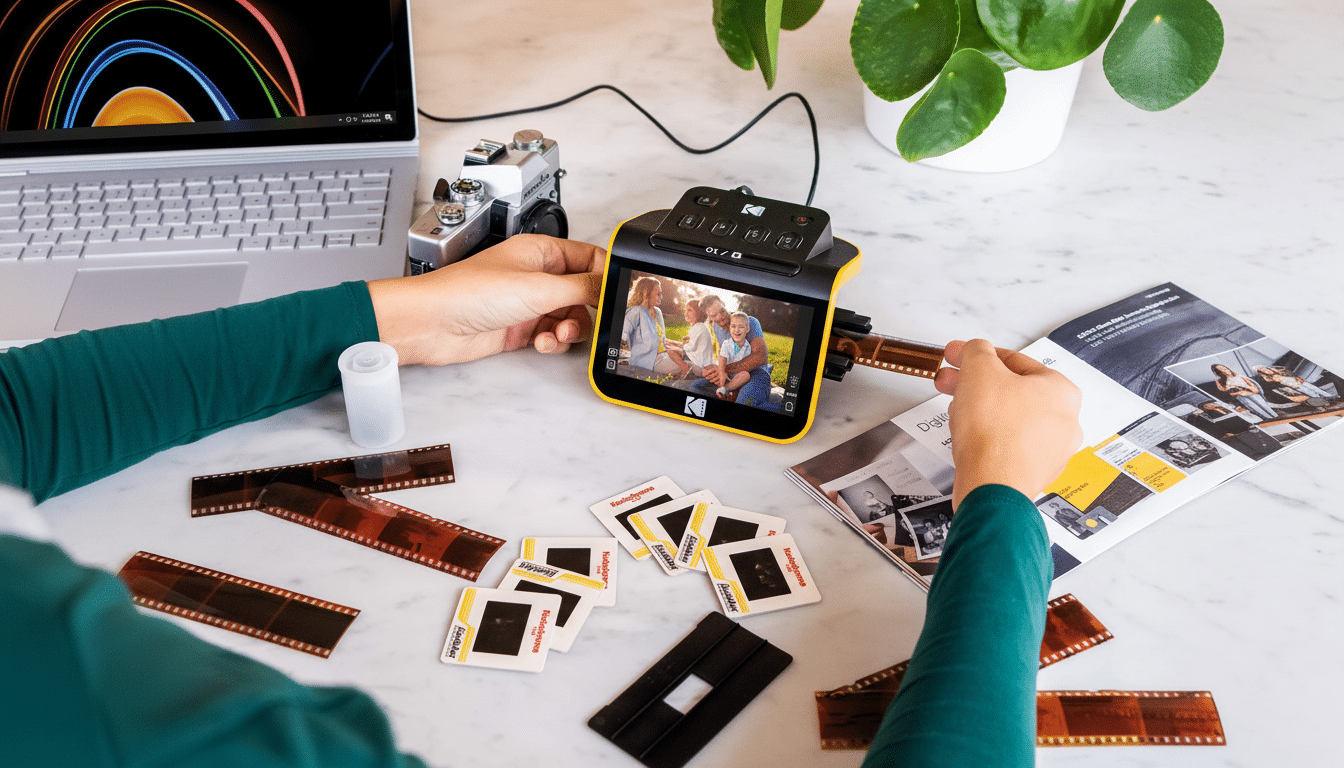It just got a little easier and cheaper to preserve decades of family photos. Now $164.97, the Kodak Slide N Scan Film & Slide Scanner is down to a more manageable $25 off its usual asking price of $189.99 and represents a well-timed grab before the holiday sales rush for anyone with boxes full of 35mm negatives or sleeves of slides sitting in the wings.
This portable device turns film into digital files without a computer, transforming shoebox archaeology into an easily manageable weekend project. For families consolidating archives or gifting the project of a memory, the savings make an already accessible tool even more appealing.
- What this early deal accomplishes for film scanning
- Key specs and supported formats for Slide N Scan
- Image quality expectations and realistic scanning results
- Workflow tips to cleaner scans and easier archiving
- Who it’s for and what features to look for in use
- Bottom line on this early Kodak Slide N Scan discount

What this early deal accomplishes for film scanning
For $164.97, that amounts to about 13% off a popular consumer scanner designed for speed and simplicity. Even compared with mail-in digitization services that tend to charge per frame, a DIY scanner can pay for itself within the first handful of images — two or three, even when transforming hundreds of pictures.
It’s also about control. You choose what to keep, how to crop, and when color should be adjusted — preferably while watching the kind of live-on-the-device preview that will make you want to switch from regular snaps.
Key specs and supported formats for Slide N Scan
It supports 35mm, 110, and 126 formats for all the common consumer film of the 1960s to early 2000s. With a sharp 5-inch LCD, you can preview every frame instantly and tweak color balance or exposure on the fly to correct those cyan-shifted or magenta-shifted prints that so often afflicted aging film.
Files save to an SD card as JPEGs for easy transfer, and you can plug into a TV or computer for larger viewing and fast sharing.
Easy-load trays keep the flow going (which is important if you’re doing hundreds of frames).
Image quality expectations and realistic scanning results
Scanners in this class scan the image using a physical sensor instead of using focusing techniques. Your scanning projects now have a cleaner, more streamlined device from which to work. The Slide N Scan produces native 14-megapixel image files, interpolated up to a 22MP equivalent resolution. On 35mm, that’s roughly equivalent to around 3000 DPI — enough for excellent-quality 8x10s and very good-looking 11x14s with decent post work.
Like most consumer film scanners, you won’t get the infrared dust and scratch removal of pricier pro gear, and dynamic range won’t quite compete with a high-end flatbed. For family archives, the output is more than good enough — typical-family-stuff (vacations, school events, and milestone moments) quality, especially after basic edits in a photo app.
“Color negatives can drift over time,” industry archivists always tell me, “especially if they’ve been subjected to heat and humidity damage.” Color and exposure controls are built in to make it easier, among other things, for photographers to correct those shifts at capture and do less heavy editing later.

Workflow tips to cleaner scans and easier archiving
Always handle film by the edges and blow off dust with a blower before each scan. Even a quick puff can save minutes of spot-healing after. An anti-static brush can assist on stubborn frames, but stay away from harsh cleaners.
Small color and exposure changes on the preview screen are preferable to pushing extremes after the fact. If a frame appears heavily faded rather than distorted, try displaying it with just a gentle lift in contrast and a nudge in white balance, and add subtle saturation.
For long-term preservation, follow the 3-2-1 backup rule advocated by digital preservation specialists: three copies of your files, on two different media types, and one copy off-site or in the cloud.
The Library of Congress also advises storing originals in archival sleeves somewhere cool and dry once digitized.
Who it’s for and what features to look for in use
The scanner is well-suited to families, genealogists, hobbyists, or amateur photographers who prioritize speed and convenience over museum-quality output. Whether you’re archiving a lifetime of slides for a reunion video call, or preserving an entire family library in digital form, the combination of quality and simplicity can’t be beat.
Power users eyeing 16-bit TIFFs, high dynamic range, or the ability to work with medium-format film will probably be happier with a more specialized flatbed scanner that’s optimized for their final output format, like those popular photo-centric models equipped with film holders, but those options are more expensive and generally slower. For the occasional frame that deserves maximum fidelity, a single high-resolution lab scan is still a smart add-on.
Bottom line on this early Kodak Slide N Scan discount
Available with a $25 discount, the Kodak Slide N Scan reduces the barrier to converting those collections of old film and slides into digital files and provides a quick, intuitive method for preserving memories that are otherwise doomed to deteriorate in storage.
If saving the family history is on your to-do list, this early deal is just the thing you need to actually get it done.

